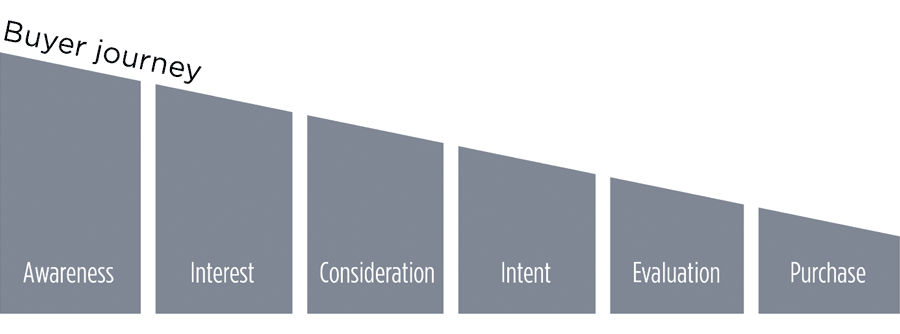Helloooo Longmont! Thanks for hanging with us today, and thanks in advance for the delicious beer.
View our full presentation here. Additionally, here are the handy brand assessment tools we mentioned. Read on and ponder, download the buyer persona and buyer journey worksheet, download the positioning worksheet and get crackin’.
Small Business Buyer Persona and Buyer Journey Worksheet
Know thy buyer, know thyself
A key early step in the Brand Assessment process, buyer journey maps identify strengths in your current positioning, illuminate weaknesses and ultimately work to align sales and marketing efforts.
In part 1 of the sales and marketing alignment roadmap, we detailed how sales and marketing departments can work together more effectively throughout the entire buyer journey. Here, we’ll cover how to map out your buyer journey.
We often find that clients have a strong understanding of their buyer journey and can describe it fairly well in conversation, but they’ve never actually documented it.
As all sales and marketing efforts are fluid and ever-evolving, it’s important to document your buyer journey accurately — as it stands right now. If you don’t have all the answers now, that’s fine. Document what you know and what you know you don’t know. It’s likely you’ll revisit and refine your buyer journey maps as your brand develops.
It’s also worth considering when marketing innovative technology companies, there are three unique types of people in your sales cycle: influencers, validators and deciders. Each have distinct emotional triggers and require specialized messages and materials. For a deeper dive, dig into our Davetech vs. Goliacorp article.
Every brand is unique, but we find most tech clients travel the following path when making a buying decision:
 Awareness
Awareness
Before a buyer can enter the market, they need to clearly know they have a problem. They may know they have a problem but don’t seek a solution because they don’t think one exists. They may require some education to fully understand the problem they have. To better position your brand as a possible solution, answer the following:
- What specific problem does your potential client have?
- How are you uniquely qualified to solve it?
- How aware are they currently that your solution exists?
- What marketing and sales materials are currently available for buyers at this stage? Answer this for you and your competition.
Interest
The customer has expressed some level of interest in finding a solution to their problem. They’re broadly reviewing solutions and starting to qualify and disqualify various companies. You may know they’re in the market, you may not.
- What’s the likelihood they’d find you when broadly seeking a solution?
- How are they likely to seek a solution: web search, referral request, RFP, don’t know?
- What marketing and sales materials do you currently use for buyers at this stage?
Consideration
Leads come in through sales efforts, your website, referrals or VARS. How do you currently interact with potential buyers who are seeking your solution?
- We have materials already created to share with them at this phase.
- We have a conversation — no sales materials.
- We send them some info, then either they or we follow up.
- What marketing and sales materials do you currently use for buyers at this stage?
Intent
The customer is going to buy from you or someone else. They are looking for a reason to decide. Do you:
- Sit back. Don’t hard sell. They’ll come in.
- Offer incentives to seal the deal now.
- Work to identify, address and remove any remaining barriers to sale.
Evaluation
The buyer is actively comparison shopping. Do you:
- Hold tight. We got this.
- Offer objective comparative data between your solution and the competition’s.
- Try to get face time and close the deal.
Purchase
Cha-ching! You made the sale. But the hard work has just begun. Now you have to deliver as promised. What are your next steps?
- File them in the closed deals folder and move back to working prospects.
- Continue to interact with them to make sure they remain happy.
- Work to convert them from happy customers to brand advocates.
- Empower and incentivize them to become brand advocates. Actively solicit referrals. Reward those referrals.
Do your best, then move on
Alright. You’ve built buyer personas and documented your buyer journey. Print it out, file it and be prepared to revisit and refine it as your brand develops.
Next, move on to assess and refine your positioning to make sure you sound as good as you truly are and your message is dialed in for buyers at each step along their journey.
Small Business Positioning Worksheet
Know your place in the space
A critical first step in the Brand Strategy process, positioning is equally valuable for your internal team as it is your external audience. For innovative tech companies, specifically startups, the positioning process often illuminates different internal perspectives on the company’s positioning.
Like putting on your own oxygen mask before helping others, it’s critical you reach internal consensus on positioning before you start to share it externally. When sales and marketing efforts are misaligned, the root cause is often varying perspectives on company positioning.
In this exercise, you’ll define who you are as a brand, who you’re not, where you’re going and how you’ll get there. Your brand positioning gets to the essence of who you are — articulating the inherent value of your offerings and explaining how you differ from your competition. Answer the following questions, and feel free to add expanded notes below each question.
Organization
Do you have your mission, vision, values and business plan written down and does your team agree on them?
- Yes, it’s the first thing we hand to new employees.
- It’s not written down but everyone should know it.
- No, we are still figuring it all out.
Does your company have a clearly defined brand position (unique value proposition)?
- We have a truly distinct brand position that stands out in our market.
- We haven’t worked out the specifics on our position.
- I don’t know.
Have you clearly articulated your brand position to internal and external audiences?
Yes, it’s documented and shared with all internal and external audiences.- We don’t have a well-defined position.
- I don’t know.
Do you consistently use the same language when you talk about your company?
- I have a brand story dialed in that really resonates and connects with prospects.
- It depends on who I’m talking to.
- I can talk about the tech, but I have a hard time talking about the brand stuff.
Technology and Marketplace
Can you easily and clearly explain how your technology is superior to the big players in the market?
- I have a library of reports and white papers I can share.
- It’s complicated, but I can explain it If you have an hour and a white board.
- I can give you the elevator speech and show you my pitch deck.
Can you clearly explain the difference between your products’ features and benefits?
- Yes, I know how to sell the sizzle and not just the steak.
- I know the difference but have a hard time distinguishing them.
- The features are the benefits.
Can you clearly articulate the big guys’ weaknesses?
- Absolutely, that’s why we built our technology.
- I have a good feel for it, but it’s not articulated well.
- We haven’t gone through the exercise of identifying our competitors’ weaknesses.
Customers
How well can you identify your potential customers?
- Everyone is my potential customer.
- I have a sense, but I don’t know who or where they are.
- I have a database of names, emails and profiles.
Do you know the steps prospective customers take to choose your product?
- Yes, we have a documented map of the process step-by-step.
- I think I know it, but it’s not documented anywhere.
- I’ve never thought through the process.
Do you know what steps customers are taking to find you now?
- Yes, I know exactly how people find us now, right down to the keywords and data.
- I have a sense, but I can’t put my finger on it.
- I don’t know.
If you had five words to tell a customer why they should choose you, do you know right now what those five words are?
- Yes, it’s printed out and hung up at my desk.
- It depends.
- I have no idea.
Start building brand love
You’ve got your buyer profiles built, buyer journeys mapped out, positioning dialed in internally and externally — now it’s time to make sure you look and sound as good as you truly are. Some innovative technology companies’ funding allows them to engage a branding firm early on in the Brand Assessment phase, helping them map buyer journeys and map out positioning. Some companies prefer or need to do this work in-house. Brand Assessment does not need to be done by an agency, but it needs to be done. It’s critical this foundational work is done prior to developing branding and marketing materials.
So rock on. Brand Assessment is like exercise: If it hurts, you’re doing it wrong. The process should be fun, challenging, enlightening and, ultimately, provide a clear path forward for Brand Development.
—————————————————————
About Toolbox Creative:
At Toolbox Creative, we’re dedicated to bridging the gap between the science of science and the art of selling it — building love connections between technology brands and the customers that love them.
Toolbox Creative offers a powerful engine to grow technology brands and take on the big players in the field. We help innovative technology companies look and sound as good as they truly are, increasing brand equity, boosting media buzz and making the most of marketing dollars.



